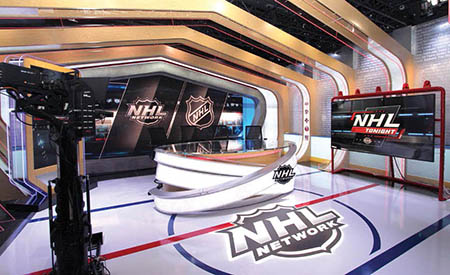NHL, MLB Networks’ ‘DIAMOND’ in the Rough
SECAUCUS, N.J.—Every night during the National Hockey League regular and post-season, the NHL Network keeps millions of TV subscribers glued to their sets with hours of pre-game, in-game, and postgame programming. During “NHL Tonight,” the network’s flagship nightly studio program, the combined on-air and behind-the-scenes crews are constantly watching every single game live; grabbing highlights and news hooks as they happen.

The NHL Network’s live studio shows broadcast from a dedicated space known as “The Rink.”
The result is a madcap yet disciplined production environment where the “NHL Tonight” production unit puts together their live show seemingly as it happens. “We literally don’t know what’s coming next past 15 seconds,” said Josh Bernstein, the NHL Network’s senior coordinating producer. “But thanks to the professionalism and dedication of our on- and off-air talent, the resulting content always looks polished and compelling.”
Here’s the kicker: The advanced production technology that underlies the NHL Network’s broadcasts comes from Major League Baseball, of all sports. Thanks to a 2015 media rights agreement between MLB Advanced Media (MLBAM is MLB’s digital business) and the NHL, the NHL Network has moved from its former Toronto headquarters to facilities in Secaucus, N.J. that are shared with MLB Network. “We’re actually in the same building, right down the hall from each other,” said Bernstein.
PLAYING WELL TOGETHER
At first glance, it may seem strange to think that MLB Network and the NHL Network could make good production partners. But they do, for a very simple reason: They follow a similar format of producing comprehensive live studio programming with real-time replay and analysis, plus post-game highlights and news coverage across each league.
MLB Network has put considerable thought into developing its advanced production systems. A case in point is MLB’s “DIAMOND” media asset management system. DIAMOND was designed internally with Boolean Consulting to precisely support MLB Network’s approach to producing live studio content, including the incorporation of live replays, archival footage on demand, and statistical/graphical analysis overlaid on top of video in real-time. DIAMOND also allows the attachment of metadata and tags to game footage, making it accessible and searchable on the web and mobile platforms.
When the NHL signed on with MLBAM, “our challenge was to reconfigure DIAMOND to specifically fit the NHL Network’s production needs, rather than just make it adapt to MLB’s system,” said Tab Butler, MLB Network’s senior director of media management and post production. “So we rebuilt the system with the NHL in mind, right down to replacing the ‘Base on Balls’ feature with ‘Shots on Goal.’” The resulting cloud-based media asset management system, which connects to the NHL’s video archives in New York City, has been appropriately named “DIAMOND On Ice.”
Get the TV Tech Newsletter
The professional video industry's #1 source for news, trends and product and tech information. Sign up below.
A second similarity between the production goals at NHL Network and MLB Network is the use of Piero, Ericsson’s real-time sports 3D graphics system. Piero allows NHL Network producers and editors to quickly create and display meaningful 3D analytical graphics on top of just-recorded game content.
STATE-OF-THE-ART NHL
The NHL Network’s live studio shows come from a dedicated space known as “The Rink.” Visually, The Rink, with its multiperson anchor desk, looks spectacular. The set is framed by four 30-foot angled arches, with 14-foot tall studio walls etched with the names of the past 10 Stanley Cup Champions. Behind the 10-foot long desk, which sits on a hockey rink-style floor, there’s a back wall LED display that measures 20x12 feet. Along one of The Rink’s side walls, you’ll find a 98-inch monitor hanging within a 7-foot goal design piece lined with five lights along the crossbar.
“We’ve made the most of our space by using three Sony P-1 cameras with Canon lenses; all mounted on a Ross Video Furio robotic camera system with lifts and tracks,” said Butler. “The Furio system allows us to preprogram sophisticated camera moves that really bring the broadcast to life, conserving technical space to accommodate a larger set.” Editing is done using DIAMOND On Ice and Adobe Premiere. Switching is done on a Grass Valley Kayenne switcher in a nearby NHL Network control room, the same switcher used by MLB Network, so that both networks can use any control room should the need arise. Also deployed are Grass Valley’s Nvision video router, NetApp E-Series disk storage for production editing, and EVS XT3 video servers for fast turnaround of live highlights.
James Careless is an award-winning journalist who has written for TV Technology since the 1990s. He has covered HDTV from the days of the six competing HDTV formats that led to the 1993 Grand Alliance, and onwards through ATSC 3.0 and OTT. He also writes for Radio World, along with other publications in aerospace, defense, public safety, streaming media, plus the amusement park industry for something different.

